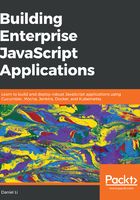
Examining the req object
Now, stop your API server (if you're running it), go back to src/index.js, open up the Debug panel, select one of the two configurations we just defined, and click the Start Debugging button (?). This time, you should see it succeed:

In a new tab, navigate to localhost:8080. This time, you won't see our Hello, World! text; this is because our server hasn't provided a response yet! Instead, it has paused at the breakpoint we set.
On the left-hand side, we can see a tab called VARIABLES, and here we can see all the local, closure, and global variables available at our breakpoint. When we expand the req variable, we'll find the method and url properties, which are exactly what we need:

We've added several VSCode debugger configurations and should commit these changes to our Git repository. The VSCode configurations are, however, not part of our Create User feature, and should be committed directly to the dev branch.